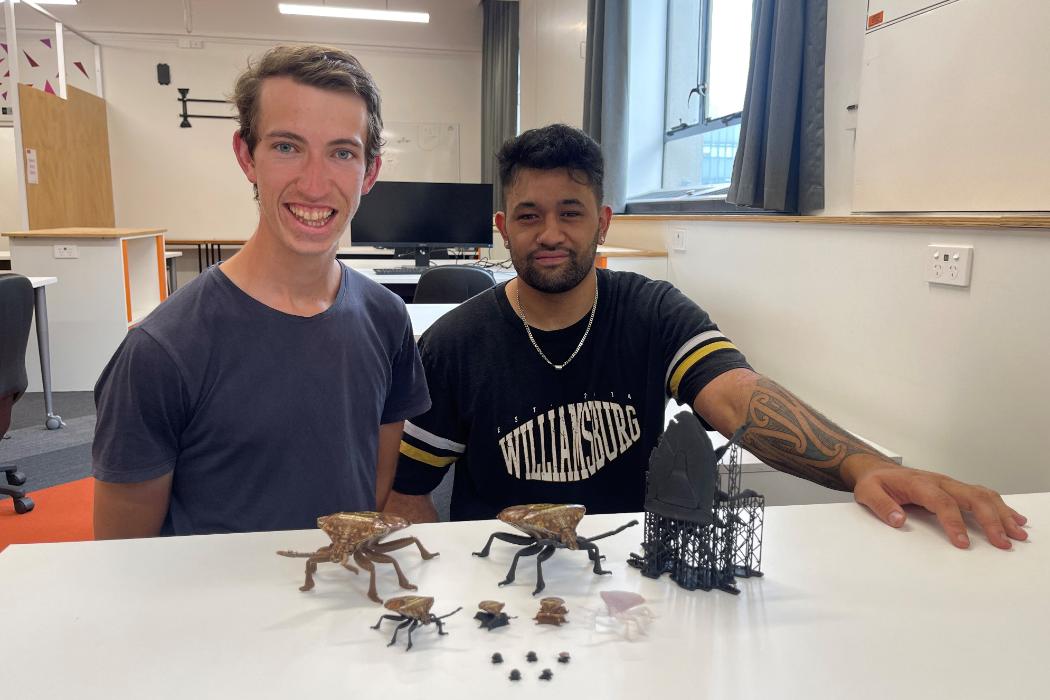Two University of Canterbury students spent their summer developing and 3D printing a model of a stink bug to raise awareness about the potential for a costly invasion of the pest in Aotearoa New Zealand.
The project, based at Te Whare Wānanga o Waitaha | University of Canterbury’s School of Product Design, has seen Joel Tregurtha and Te Matau O Te Rangi Allen (Te Ati Haunui-a-Pāpārangi, Ngāti Rangi, Ngāti Tūwharetoa) develop and 3D print a prototype larger than life-size model of the brown marmorated stink bug, which is about the size of a 10 cent coin.
Tregurtha is studying towards a Bachelor of Science, majoring in Biological Sciences, and was drawn to the project because he wanted to find out more about the bug.
“I’m interested in the biology side of the project. Sculpting the bug has made me really appreciate the intricate details in the bug’s exoskeleton and realise how incredible it is that they can grow working antennae and legs that are so tiny and thin. They are a beautiful bug, despite being a very bad pest.”
Allen is studying towards a Bachelor of Engineering in Mechatronics and was interested in the practical challenge of bringing the bug to life.
“A part that really interests me is the 3D printing side of this project and being able to use printers that I haven’t had experience on, such as resin printers. The biggest challenge is 3D printing small, thin parts, as small 3D prints can make it difficult to show finer detail and cause the print to be very fragile. We also don’t want to make it look too realistic.”
The project is part of the Better Border Biosecurity (B3) summer studentship programme. B3 is a research collaboration involving Crown Research Institutes, universities, government, industry, iwi and other stakeholders, that aims to strengthen Aotearoa New Zealand’s biosecurity system and protect the country’s valued native flora from invasive pests.
The stink bug model is a direct outcome of a Memorandum of Understanding (MOU) between Better Border Biosecurity (B3) and University of Canterbury Biosecurity Innovations (UCBI). The 3D model, which takes about 16 hours to print, could, in future, be used as part of a public awareness outreach programme.
For example, the models might be added to biosecurity trails in Auckland, Wellington and Christchurch Botanic Gardens, used in various children’s activities including augmented reality, or at grower field days.
B3 Director David Teulon says the brown marmorated stink bug is a major crop pest that could have significant economic ramifications if it became established in Aotearoa New Zealand.
“The BMSB is an east Asian bug now found in North and South America and Europe. It is a particularly difficult pest to eradicate and control, devastating horticulture and causing a nuisance overwintering in homes. As a hitchhiker, the risk of it arriving in New Zealand is high. It is not yet found in New Zealand but is often intercepted at the border. According to the New Zealand Institute of Economic Research (NZIER), the potential impact of an invasion of the bug could cause GDP to fall between $1.8 billion and $3.6 billion by 2038, and horticulture export value to drop between $2 billion and $4.2 billion by 2038.”
UCBI Director Dr Stephen Pawson says the multi-disciplinary project builds biosecurity capability in engineering, biology and product design.
“This project is exciting as it provides an opportunity to engage more closely with our B3 collaborators and encourage interactions between academics and scientists in Crown Research Institutes. It also helps with increasing the recognition of what equipment and skills we have at UC. For students, it is about working with a real client and working on real life projects.”
Find out more about the University of Canterbury at canterbury.ac.nz.
Subscribe to our Newsletter
3DPResso is a weekly newsletter that links to the most exciting global stories from the 3D printing and additive manufacturing industry.























